|
Home
Origins of the LRGAF
Deadly Equines
Voices of
Authority
Equestrian Wisdom & History Books
An
Equestrian Writer's
Guide
Academic Research
Historical Research
Military Research
Medical Research
Equine Slaughter & Hippophagy
Breeds & Equestrian
Tribalism
Literary Research
Legends & Myths
Horsemanship
& Training
Astonishing Rides,
Rescues & Races
Equestrian Inventions
Friends

Visit The Long Riders' Guild!
Website designed by Basha O'Reilly
| |
|
Sidesaddles and
Suffragettes
The Fight to Ride and Vote
by
CuChullaine O'Reilly FRGS |
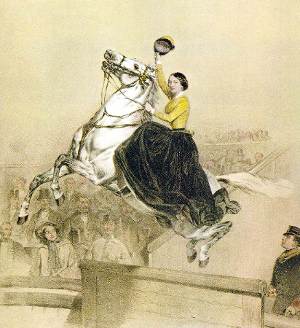
|
In an age when many American women
take their political freedoms for granted, they would do well to recall that for
nearly a thousand years their mounted ancestors enjoyed neither political nor
equestrian equality.
One piece of equipment, the
sidesaddle, represented this social, political and equestrian domination.
And while it is common knowledge that
the Suffragettes achieved the right to vote in 1920, what has gone undetected is
that these brave women rode into the voting booth as second-class citizens on a
sidesaddle, then galloped out astride.
Thus, an equestrian revolution came
about due to a second, undeclared and hitherto forgotten, civil war which tore
the American nation into conflicting camps. This deeply divisive social
conflict, which was waged from ocean to ocean, wasn't between the men of the
North and South. It was conducted between the two opposing female equestrian
cultures of East versus West.
Yet we can't look for answers "out
West," without first recalling how women swung into the saddle.
ORIGINS OF RIDING
|
Like their brothers, the original
Central Asian women riders mounted up in order to participate in travel,
sport, war and pleasure.
The most famous early example
were the Amazons, whose daring exploits in the saddle upset generations of
Greek men, as those toga wearing pedestrians quailed at the idea of meeting
hard-riding, trouser-wearing women. |

An Amazon riding astride |
Nor was the idea of mounted women
geographically restricted, for equestrian cultures including the Mongols,
Comanche and Hawaiians later took justifiable pride in the equestrian skills of
their women.
The reason these sisters of the
saddle rode was explained by the Danish equestrian philosopher/author, Bjarke
Rink, who pointed out in his book, The Centaur Legacy, that the horse turned
"man"-kind into a race of risk takers. History, Bjarke says, is about how
mounted humans changed the face of the globe.
But if men like Oscar Wilde, Lord
Byron and Charles Darwin became Long Riders and risk takers, did women mounted
astride become social reformers?
Not without a fight.
TRANSITION IN THE AGE OF CHIVALRY
|
We can't appreciate what was lost, without understanding
what women once enjoyed.
During the 1200s authors such as Chaucer wrote about
women who routinely made lengthy journeys riding astride. The rowdy and
earthy "Wife of Bath," depicted in The Canterbury Tales, was one such
notable character. She rode a pacer astride, carried a whip and wore spurs.
Other women also adapted split skirts, or, if riding to war like Joan of
Arc, donned armour. |

Chaucer's Wife of Bath |
Thus, before the dawning of the fourteenth century, women rode astride, or they
rode pillion - sitting sideways on a cushion behind the male rider's saddle. The
pillion had become more common as European female fashions developed into
increasingly elaborate court dress which restricted a woman's movements.
Though it may be true to say that the clothes a woman wore influenced the future
of equestrian history, that isn't why the sidesaddle was invented.
PROTECTING THE ROYAL HYMEN
The dictionary defines a "Bohemian" as being a nonconformist who lives an
unconventional life. Yet in an incredible historical irony, it was a woman from
Bohemia who caused nearly one thousand years of equestrian repression to
transpire.
With the rise of feudalism, and its
off-shoot, patriarchal politics, the need to secure a male heir was an affair of
state and protecting the virginity of a potential royal bride became
increasingly vital. One way to protect the royal hymen, and off-set the
accidental loss of virginity, was to prohibit aristocratic girls from riding
astride.
Thus sidesaddle riding was introduced
into England in 1382 when Princess Anne of Bohemia travelled across Europe via
this new mode of equine transport in order to wed King Richard II.
For those unfamiliar with the history
of coaches and carriages, it is important to note that due to the lack of
passable roads, driving a coach as a common form of transport would not take
place until the dawning of the 19th century.
That is why, lacking a road, the
virtuous virgin was transported to England in a chair like affair that was based
upon a packsaddle design. In addition to a padded seat, this new contraption
provided a pommel in the front which could be used as a rudimentary handgrip. A
wooden plank, wide enough to accommodate both feet, hung along the left side of
the placid beast of burden. It was customary for the sideways facing woman to
sit on the near side of the horse, enabling her to use the right hand to hang
onto the horse's mane.
From routing Greek foot soldiers, once-bold women had thus been reduced to the
status of packages being delivered to the highest political bidder. The reins,
both of personal power and individual equestrian control, had been taken away by
men who now restricted a woman's political and equestrian destinies.
Thus the advent of the sidesaddle can
be traced back to the English court and this Bohemian queen. For the next two
centuries the sidesaddle became increasingly associated with "proper" behaviour,
until by 1600 riding astride was no longer something a "lady" would do, as that
ancient practice had taken on the aura of indecency.
FASHION NOT FUNCTION
|
Not all women bought the idea of
riding sidesaddle, though the longer the sidesaddle was around and the more
it was used by royals, the more society believed it was the proper way for a
woman to ride. For example, public opinion was of no particular consequence
to Catherine the Great, the Empress of Russia (1729-1796), so she rode
astride and demanded that all women in her court follow suit.
However a strong implication now
dominated the European horse world. An unwritten law stated that only a
woman as masculine as an Amazon, as libertine as the Wife of Bath, or as
heretical as Joan of Arc, would have dared to ride astride. |
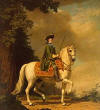
Catherine the Great of Russia |
|
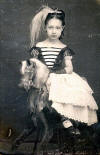
Learning early how to ride like a lady |
In this way by the end of the
nineteenth century a philosophy of equestrian protection had become an
entrenched social institution, one whose original purpose wasn't discussed in
public, yet which nevertheless exerted an immense influence across polite
European and American society.
|
MECHANICAL
SOLUTIONS
Though the sidesaddle began as a
flat, padded platform it soon underwent several mechanical transitions, which,
though designed to provide the female rider with more control, ended up
entrapping her.
The first great change was the
addition of a horn which enabled the rider to wrap her right leg around this
projection in order to obtain stability. The addition of a second horn was
attributed to Catherine de' Medici. This improvement allowed the rider to face
forward and gain a further sense of security.
By this time the footrest had been
replaced with a leather covered slipper stirrup which housed the left foot. This
interim system permitted the rider some stability, at least at slower speeds.
|
In the nineteenth century a third
horn, called the leaping head, was added to the sidesaddle. According to
James Fillis, a famous French riding master, this new style sidesaddle gave
women "security at all movements of the horse, no matter how brusque or
violent."
He went on to exclaim that,
"Nothing evokes such elegance as riding sidesaddle." |

Traditional riding habit, circa 1890 |
While it was true that certain daring
women used this improved sidesaddle to jump their horses more than six feet, and
ride to hounds across England and Ireland, what the riding master neglected to
mention was this combination of horns also locked these women into place on top
of a notoriously dangerous animal capable of immense speed and lightning fast
evasive manoeuvres.
THE PERILS OF REPRESSION
Though today it is often described
as a "romantic" way to ride, modern equestrians are reluctant to discuss the
deadly side effects associated with locking a human body into place alongside
the left side of a galloping horse.
The drawbacks included these
dangerous disadvantages to horse and rider.
|
Concessions to fashion ensured
that the immense riding skirts, as well as special corsets, kept the rider
erect, rigid and uncomfortable. Additionally, the sidesaddle was labour
intensive. A man could mount alone. Yet it took two men to help one lady get
onto her sidesaddle.
It also handicapped the rider
in another way, communications, as unlike male riders a sidesaddle rider
could not apply the pressure of her leg to the right side of the horse, nor
give her mount any signals with her thighs, knees, or heels.
Even worse, she could not drop
her hands in order to turn or stop a runaway horse.
|

It took
two men to help one lady get onto her sidesaddle. |
| Sadly, if she
was involved in an accident, a girl was more likely to suffer serious
injuries in a sidesaddle. When fox hunting men had riding accidents, the
small English saddle was designed to throw them free of the massive horse.
But when the horse of a female fox hunter fell, the heavy sidesaddle trapped
the women underneath the 1200 pound animal because she could not fall clear
of the saddle. Even worse, she could not drop her hands in order to
turn or stop a runaway horse. |

She could not drop her hands in order to turn or stop a
runaway horse. |
The result was that these women
often had their backs broken and were invalids for the rest of their lives.
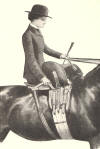
Adjusting the girth |
In addition, the sidesaddle was
notoriously expensive to create and because it placed the majority of the
weight on one side, it routinely injured the horse's back. Plus, because of
the long flapping riding dress hanging along his left flank, a "lady's
horse" had to be exceptionally well-trained, which translated into
"expensive." Finally, because of its bad fit, grooms were known to girth a
sidesaddle up so tightly that the horse had trouble breathing.
The result was that women, and
horses, suffered devastating physical abuse.
Nevertheless, a noted British
riding master, Colonel Hitchcock, urged women to continue with the method
because, "the sidesaddle is the most decorative, dignified, and graceful
method, and pleases the male eye, which prefers the ultra-feminine woman to
the type which emulates the male in attire or atmosphere." |
AN
EMERGING SOCIAL DEBATE
What the fans, and foes, of the
sidesaddle could not have foreseen was that as the 19th century drew to a close,
this revered icon was about to become involved in a global equestrian debate
which raged through the press and across the world of the Long Riders.
After Long Rider Daisy Bates migrated
from Ireland to Australia in the 1880s, she rode three thousand miles in her
sidesaddle across the Outback. Likewise, when Ella Sykes, the unconquerable
English Long Rider, set out to canter across the deserts of Persia, it wasn't
the local Muslims who almost slew her, it was the sidesaddle which nearly took
her life on several occasions.
|
It was during this time period
that Alice Hayes, a British author and strong advocate of the sidesaddle,
warned the English speaking world that the only people advocating ladies to
resume riding astride were "journalists short of copy and women anxious for
notoriety." Hayes went on to denounce "feminine desperados" who, being
either "mad or wholly ignorant," had forgotten how "ungraceful" riding
astride made a woman look.
Yet while Hayes and Hitchcock
worked hard at protecting the equestrian status quo, lady Long Riders were
quietly breaking down social and equestrian restrictions on both sides of
the Atlantic. |

Alice Hayes atop her zebra |
LADY LONG RIDERS DEFY THE
RULES
When she ventured to Hawaii in the
late 19th century, English Long Rider Isabella Bird, learned to ride astride
thanks to her Hawaiian hosts. In addition to rounding up the wild cattle
imported by the King of that island, the Mexican vaqueros had also taught the
local women to ride astride. Bird not only adopted this technique, she used her
vaquero saddle when she later explored the Rocky Mountains, Japan, Persia and
Tibet on horseback.
Similarly, when Ethel Tweedie left
London, she had not planned to forsake the sidesaddle. Yet like Isabella, upon
her arrival in Iceland, Ethel discovered that the local women rode astride like
their male relations.
|
"Necessity gives courage in
emergencies, so I determined to throw aside conventionality, and do in ‘Iceland
as the Icelanders do.' The amusement of our party when I overtook them, and
boldly trotted past, was intense; but I felt so comfortable in my altered seat
that their derisive and chaffing remarks failed to disturb me. Riding
man-fashion is less tiring than on a side-saddle, and I soon found it far more
agreeable, especially when traversing rough ground. My success soon inspired
Miss T. to summon up courage and follow my lead. Society is a hard task-master,
yet for comfort and safety, I say ride like a man," Tweedie recalled. |

English Explorer Ethel Tweedie riding astride in
Iceland |
EAST
VERSUS WEST - AN UNDECLARED CIVIL WAR
|

Riding with Father |
As the 20th century dawned, despite
the brave attempts of role models like Isabella Bird, the majority of "nice"
girls in America and England were still doomed to ride perched on the side of a
horse and not, as one western wag put it, astride "like a clothes pin." How was
it then that the sidesaddle, which had enjoyed such a run of success, was about
to disappear from use without a whisper, or a regret, in less than a generation?
The signs were there for those who
understood them. Moreover, these omens carried geographic clues indicating that
a host of defiant Western women were no longer willing to acquiesce to New York
and London.
|
Such social battle lines could be
seen on either side of the United States, where, for example, the New York Times
reported that riding as a social past time in Washington DC had reached an all
time high, with an estimated "200 maidens out riding every week." In this city,
proper ladies, such as Mrs. Senator Davis, whose "cheeks have so much colour in
them that people charge her with painting, but this is a slander," were noted
for their "perfectly fitted custom made riding habit."
|
Meanwhile on the other coast, the Los
Angeles Times reported that twenty-five women had been elected to the
prestigious Vaquero Riding Club, whose members were all expert horsemen and
descendants of Spanish grandees. The paper also noted that all of these
Californian equestriennes preferred to ride astride. "Not one of us would
tolerate the old-fashioned sidesaddle," a liberated Angelino rider reported.
Nor was this new generation of
Western women willing to quietly withhold their political and equestrian views
any longer.
|

Demanding her rights |
In September, 1910, Two Gun Nan
Aspinwall set off to prove that a woman could ride "ocean to ocean" alone. The
Long Rider's journey took her from San Francisco to New York, during which time
she wore a split skirt, shod her own horse, and rode astride.
|
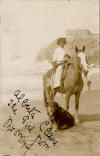
Alberta Clare, "the
girl from Wyoming" |
Yet if the equestrian powder keg needed a fuse, it was
the tiny Alberta Clare who proved that women were no longer willing to
follow the rules.
In 1912 this diminutive
pistol-packing Long Rider made an 8,000 mile solo equestrian journey across
America that took her from Wyoming to Oregon, south to California, across
the deserts of Arizona, and on to a triumphant arrival in New York City.
Throughout the course of her long journey, Clare publicly stated that she
associated her desire to vote with her right to ride astride.
Upon her arrival in New York,
Alberta was greeted by Teddy Roosevelt, who praised Clare's courage and
urged that women be granted the right to vote. |
Yet these were individual acts of
courage. What was needed was a mounted champion who could turn the tide of
equestrian history. And that woman, and her horse, were ready to lead the charge
towards political and equestrian equality.
A MOUNTED CHAMPION FOR
WOMEN'S RIGHTS
| Her name was Inez
Milholland and it was her destiny to lead an equestrian and political
revolution, the intertwined implications of which have never been previously
studied.
That is why, in addition to being
a suffragist, labour lawyer, correspondent, and public speaker, Inez
Milholland ranks as one of the most important female equestrian leaders in
American history, for it was on the back of a horse that she liberated her
sisters from the sidesaddle, as well as helping obtain them the right to
vote.
She did this by making three
rides astride which changed the political and equestrian landscape of
America in a few short months. In May, 1912 Milholland saddled up a
fractious bay and led ten thousand marchers across New York. |

Inez Milholland and Gray Dawn |
Then she headed to the nation's
capital.
Mounted on a white charger named,
Gray Dawn, Inez set out early on March 3, 1913, determined to lead an immense
women's suffrage parade several miles from the nation's Capital to the Treasury
Building. Her Joan of Arc inspired costume was "a symbol of the free women of
the future, crowned with the star of hope, circled with the blue mantle of
freedom and breasted with the torch of knowledge."
Yet the suffragettes, who were
marching on the eve of President Wilson's inauguration, had barely begun their
long walk when they were attacked by a horde of antagonists. Cut off from her
friends, and alone in the middle of the howling mob, it looked as if the drunken
thugs might pull down the suffragette rider. Instead Inez spurred Gray Dawn and
charged the rabble.
"You men ought to be ashamed of
yourselves," she shouted, as her adversaries fled.
|
Thankfully, before her bluff
could be called, U.S. cavalry troops galloped in from nearby Fort Myers. In
the ensuing melee, the cavalrymen cantered up the avenue, crashing into
civilians and clearing the way for the beleaguered suffragettes. Yet not
even the cavalry could fully contain the wrath of the attackers who darted
in behind the army, determined to kick, grab, curse, howl and spit at Inez
and her fellow protestors. As the injuries rose, ambulances were called in
to cart away hundreds of wounded spectators and suffragettes. But the women
marched on.
Finally, many weary hours later,
Inez and her fellow protestors reached their goal. The nation was aghast at
how they had been treated. Inez, however, had no time to mourn. |
Two weeks later she was in the saddle
once again. This time she led ten thousand marchers through a peaceful New York.
That was her last great ride and it ended at a rally witnessed by 150,000
people.
|
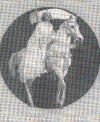
Inez Milholland |
Then, like a candle that burned too
bright, this mounted symbol of hope and equality died at the age of 30 from
pernicious anaemia.
Her last public words were, "Mr.
President, how long must women wait for liberty?"
The answer was, seven more long,
unjust years.
|
ROYALTY'S LAST STAND
In July of that year, 1913, Queen
Mary of England made a fruitless attempt to turn back the hands of time, when
she announced a royal ban on women riding astride in Hyde Park's Rotten Row.
|
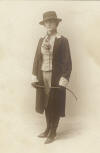
Transition in Fashion, 1910 |
Once again it was the women of
the American West who thundered out their opposition, with the LA Times
announcing, "The sidesaddle is a cumbersome, cruel burden on a horse and all
right thinking people believe its time is past." While cautioning that what
was good enough for Los Angeles was good enough for England, the paper went
on to warn, "God Save the Queen - from starting any more fool notions."
American women were finally
granted the right to vote with the passage of the 19th amendment to the U.S.
Constitution in 1920. The Presidential election of November 1920, was
therefore the first occasion on which women in all states were allowed to
exercise their right of suffrage. |
| Likewise, even
conservative Washington DC reported a simultaneous shift in the values of
their equestrian community. Before the twin liberties of voting and riding
astride were granted, the nation's capital had denounced Miss Ruth Haines
when she dared to ride astride down Connecticut Avenue. "All Washington
gasped and Miss Haines was voted ‘too Western' for the capital," the local
paper recalled. Haines' daily rides were attended by "a gaping throng" who
argued for or against the "straddle bug" riding for women. Yet soon after
the death of Inez Milholland, the paper went on to report that "all that is
changed" and even society ladies had become "full fledged straddlers." |
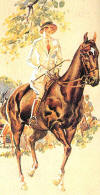
Liberated and astride in 1924 |
FREE WOMEN - FREE RIDERS
Thus, the fall of the sidesaddle is
linked to the rise of female liberty, for it was the dawning of political
freedom which brought about the overdue death of this repressive equine
invention. The extent of that dramatic social change began to be apparent in the
early 1930s when women were offered the option of equestrian equality. They
abandoned the sidesaddle in droves in favour of riding astride.
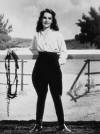
Elizabeth Taylor in National Velvet |
Then when the acclaimed film,
National Velvet, was released in 1944, women old enough to have spent their
childhood in a sidesaddle, watched the young girl, Velvet Brown, dream not of
being a pretty face but of winning the Grand National steeplechase while riding
astride. By 1946, when Brian Vesey-Fitzgerald's completed his masterpiece, The
Book of the Horse, this encyclopaedic 880 page work lacked a single reference to
the sidesaddle.
Now, with the dawning of this new
century, we will soon witness the end of the sidesaddle's last royal connection,
for though Anne of Bohemia was the first English queen to ride in a sidesaddle,
the current monarch, Queen Elizabeth II, will undoubtedly be the last ruler to do
so.
|
PANTS IN THE PRESS - HOW
RIDING SKIRTS SOLD NEWSPAPERS
|
Though a cowgirl can now dress
anyway she wants, that wasn't always the case. In fact back in the days when
the sidesaddle ruled the female equestrian world, if a cowgirl showed up in
town wearing her brother's pants, or even a split skirt, she would have been
arrested for indecent exposure.
That's what happened to Evelyn
Cameron in 1895 when the English photographer, turned Montana rancher,
cantered into Miles City one fine August day. Because Evelyn had dared to
come to town wearing a split riding skirt she had made herself, the sheriff,
backed by the town's outraged women, threatened the foreigner with arrest if
she didn't leave town.
Nor had this social prejudice
lost any of its widespread power when Two Gun Nan Aspinwall made her ride
from San Francisco to New York in 1910. She too wore a split skirt. However,
Nan lived up to her name by shooting up any town dumb enough to try and pass
judgment on her sartorial decision-making.
|
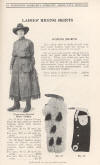
Ladies Riding Skirt by Al Furstnow Saddlery
|
Yet, as these American newspaper
articles demonstrate, the war to keep women out of pants consumed a lot of ink
and raised a nation's temper to the boiling point.
Havre, Montana - August, 1897.
There were six young women who
competed in the bronc riding competition. The broncos chosen were as villainous
a crew of ponies as ever got together. The riders wore a combination costume of
cowboy and bicycler's wardrobes. There was no pretence about sidesaddles as all
the broncos were ridden astraddle. The mix-ups were so lively that it seemed the
riders would be reduced to their high heeled boots. Sombreros and whips were
lost, the riders' long hair whipped in the wind, and their clothes had the
appearance of having been used as street sweepers. But there were no serious
rents in garments and not even a scratch on any pretty face.
Pasadena, California - June, 1904.
"I have learned that the only true
way to ride is to ride astride. The ones who object to women riding astride are
those who think a woman should ride to be seen and not for her own pleasure,"
said Miss Herma Rupe, a charming equestrienne.
Los Angeles - May, 1905.
"The woman does not live who can
throw her leg over the back of a horse without profaning the grace of
femininity; or grasp with her separated knees the shoulders of her mount without
violating the laws of good taste; or appear in the cross-saddle with any
semblance of dignity, elegance or poise," reported The Lancer, a male columnist
in the Los Angeles Times.
Indianapolis - September, 1907.
It would make an Indianapolis girl's
heart ache if she had to ride horseback like a New York maiden, who uses a
sidesaddle and affects English fashion. Yet what would the New York girl think
if she saw the Indianapolis girls in their riding skirts, bare headed and riding
astride at a merry clip? The New Yorker would shake her pretty head and say,
"We are more refined in the East." But the Indianapolis girl could wisely reply:
"Not a bit of it. You are only more conventional."
New York - February, 1911.
There is nothing particularly new in
the wearing of trousers by women and the divided skirt has been threatening us a
long while. However, the tailor-made gown is as near to the masculine fashion in
attire as most women ever care to get.
Los Angeles - May, 1917.
For Sale - Smart riding suits for
women that combine utility, comfort and trim style.
New York - May, 1924.
This season the belles of the bridle
path will be wearing a comfortable new item known as the jodhpur, which is
described as being "very swagger, indeed."
Home
Historical Research
|